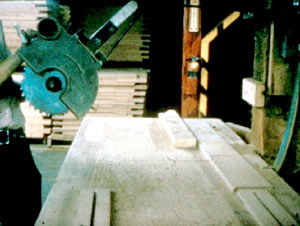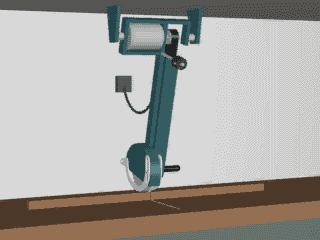Machine Guarding eTool
Saws » Overhead Swing Cut-Off Saws

A woodworking cut-off saw is a circular blade machine, usually of the radial design, used for cutting stock across and above the stock. The blade is mounted directly to the motor, which is contained in the moveable ram. The stroke may be manual or powered. The saw blade generally rotates at 3,600 rotations per minute (RPM). Stock is fed in front of the machine on a feed table with rolls and guides.
Operator Involvement
The most commonly found cut-off saw has a manual stroke. This requires the operator to position the stock, hold it stationary, and grasp the sawing mechanism and pull it across the stock. After the cut is complete, the blade must return to its original position and the stock is repositioned for the next cut.
Potential Hazard
-
Contact with the blade may occur during operation, when the saw is idling, if the return device fails, or if the saw bounces forward from a retracted position.
-
If the saw blade is able to go past the edge of the table, the blade could come in contact with the operator's body.
Solutions
-
Enclose upper half of saw and arbor end with a self-adjusting hood. The hood must drop on top of and remain in contact with the table or stock. When the saw returns to the back of the table, the hood must cover the lower portion of the blade. [29 CFR 1910.213(g)(1)]
-
Ensure that the saw contains an automatic device (for example, a counterweight) to return the saw to the back of the table after the cut has been made. [29 CFR 1910.213(g)(2)]
-
Use limit chains or other effective means (for example, extend the table edge) to keep saw from moving beyond the front or back edge of the table. [29 CFR 1910.213(g)(3)]
-
Enclose the overhead drive with a fixed guard. [29 CFR 1910.219]
Additional Safety Measures

-
Position the piece to be cut before starting the saw.
-
Stand at the side of the saw blade when the saw is running and use the hand nearest the handle to operate the saw. (This keeps the operator's body out of the line of the saw).
-
Install a latch with a ratchet release on the handle, non-recoil spring, bumper, or other device to keep the saw from rebounding from its idle position.
-
Keep hands out of the line of the cut.
Potential Hazards
-
Stock caught by the blade may be thrown back at the operator.
Solutions
-
Enclose the overhead drive with a fixed guard. [29 CFR 1910.219]
-
Make sure guards and counterweights are properly adjusted at all times. Remove improperly adjusted saws. [29 CFR 1910.213(s)(1)]
-
Remove cracked and defective saw blades. [29 CFR 1910.213(s)(7)]
Additional Safety Measures
-
Maintain sharp blades.
-
Position the piece to be cut before starting the saw.
-
Stand at the side of the saw blade when the saw is running, and use the hand nearest the handle to operate the saw. (This keeps the operator's body out of the line of the saw.)
-
Always use eye and face protection.
Potential Hazards
-
The cutting action of the blade may throw wood chips, splinters, and broken saw teeth.
Solutions
-
Enclose the overhead drive with a fixed guard. [29 CFR 1910.219]
-
Make sure guards and counterweights are properly adjusted at all times. Remove improperly adjusted saws. [29 CFR 1910.213(s)(1)]
-
Remove cracked and defective saw blades. [29 CFR 1910.213(s)(7)]
Additional Safety Measures
-
Maintain sharp blades.
-
Position the piece to be cut before starting the saw.
-
Stand at the side of the saw blade when the saw is running, and use the hand nearest the handle to operate the saw. (This keeps the operator's body out of the line of the saw.)
-
Always use eye and face protection.



 Click on image to view animation
Click on image to view animation 